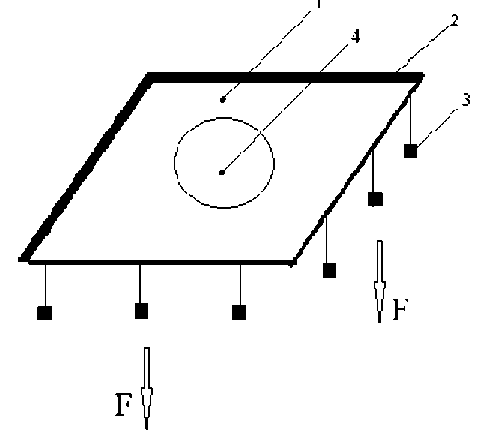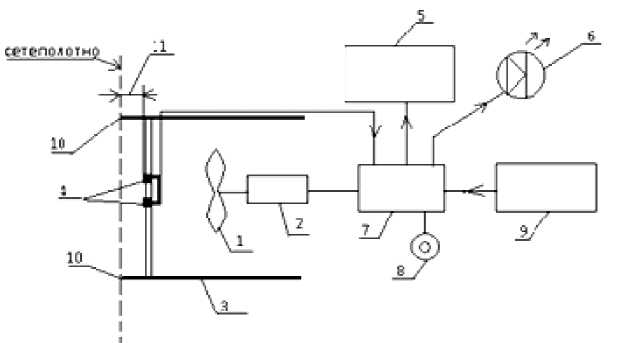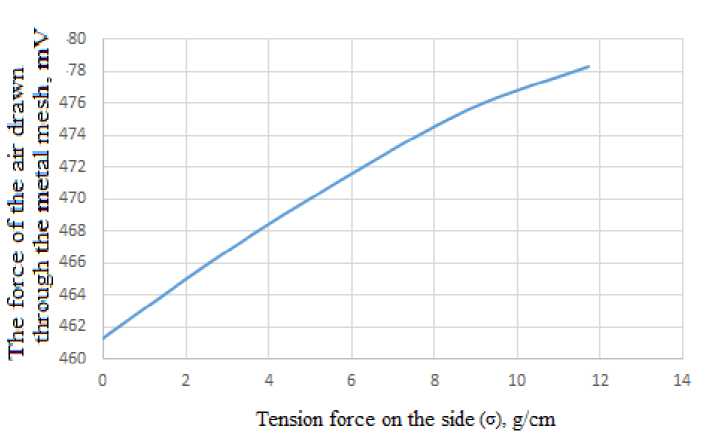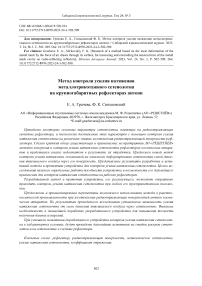Research of a method based on the local deformation of the metall mesh by the force of air drawn through its surface, for measuring and controlling the tension force of the metall mesh cavity on radio-reflecting reflectors
Автор: Gracheva E.A., Sin'kovskiy F.K.
Журнал: Siberian Aerospace Journal @vestnik-sibsau-en
Рубрика: Aviation and spacecraft engineering
Статья в выпуске: 3 vol.24, 2023 года.
Бесплатный доступ
This article presents some of the main parameters of metal mesh that affect the radio-reflective properties of reflectors and the technology for attaining these parameters by controlling the tension capacity of the mesh sheet at various stages of the radio-reflective surface manufacturing. The article also includes a brief overview of the developed methods (applied at the RESHETNEV JSC) of measuring and controlling the tension capacity of spacecraft reflectors with mesh shields, along with the analysis of the shortcomings revealed in the application of these methods. The authors introduce a new method of the tension capacity control based on the local deformation of the metal mesh by pressure of the air drawn through its surface. There are the results of development and testing of the metod, and of a model device for controlling the mesh tension capacity. The purpose of the research is to determine the operability of the device and the ways of its possible application in controlling the tension of the mesh-made reflectors ready for operation. The developed method and the model device for its application allow in-process control of the mesh tension at any spatial position of the mesh sheet. There is an analysis of possible application prospects of the method in rocket and space industry for manufacturing radio-reflecting surfaces of spacecraft antennas. According to the results of the research, the ratio of the mesh tension capacity to the pressure of the air drawn through the sheet was determined. The need for further improvement of the designed device aimed at increasing the measurement data accuracy was also pointed out.. In case the laboratory testing of the upgraded device for controlling the mesh tension capacity proves successful, further tests will be carried out in the process of sheet cutting and in the reflector shield manufacture.
Reflector, radio-reflective surface, metal mesh, mesh tension capacity, reflection coefficient
Короткий адрес: https://sciup.org/148329694
IDR: 148329694 | УДК: 681.62.066.1-026.615:520.224 | DOI: 10.31772/2712-8970-2023-24-3-502-509
Текст научной статьи Research of a method based on the local deformation of the metall mesh by the force of air drawn through its surface, for measuring and controlling the tension force of the metall mesh cavity on radio-reflecting reflectors
Desingn of fundamentally new transformable antennas for spacecraft required the development of metal mesh products, tactical and technical characteristics of which could ensure the highest reflection coefficient of microwave radiation at minimal tension force, minimum specific weight and maximum isotropy of mechanical and radio engineering properties [1–3].
The reflective surface of space communication antennas is subject to specific operational requirements, one of which is maximum radio-reflecting capacity at minimal tension of the load-bearing frame [4].
The problem of reflective surface manufacture was solved through the development of new woven metal mesh materials made of galvanically gilded wire, which best meet the present requirements for a reflection coefficient of ≥ 98 %.
The required antenna reflection coefficient depends, among other parameters, on the amount and uniformity of the mesh sheet tension over the entire diameter of the operating reflector aperture.
The article gives a review of the methods applied at the RESHETNYOV JSC for measuring and control of the mesh tension value when dealing with large-size transformable antenna reflectors; there is also a presentation of a new control method.
Formation and control of the surface profile of radio reflectors
Tungsten and molybdenum mesh with gold coating is used as the material for the radio-reflective surfaces of large-size reflectors.
To maintain the specified coefficient of radio reflection in the process of antenna deployment, the radio-reflecting surface of the corresponding profile must be supplied [5; 6].
When the profile able to eliminate sagging of the mesh shield framed by power spokes is manufactured, the mesh must have the tension determined at the JSC RESHETNYOV – conducted test session (the figures obtained see in Table 1).
The value of operational mesh tension capacity for various mesh sheet grades
Table 1
|
Mesh grade |
Mesh tension capacity, g/cm |
|
СМеТ-ЗлВ15х2(А+А) |
5 ± 1 |
|
СМеТ-ЗлВ15х2(Т+С) |
11 ± 1 |
|
СМеТ-ЗлМо20х1(А+А) |
2 ± 1 |
Control of the mesh tension capacity is specified in the design documentation for transformable reflectors and metal mesh [7; 8]:
-
– at the stage of mesh sheet cutting;
-
– at the dimensional template, when the mesh sheet is lined out;
-
– at various production stages of the reflector.
The number of control points depends on the diameter of the antenna and ranges from several tens to several hundreds.
Analysis of methods of tension capacity measurement and control maintaining the antenna radio-reflective parameters
At present, the JSC "RESHETNYOV" makes use of the following developed and industrially applied methods of mesh tension measurement and control:
-
– a method of tension capacity control based on the density of loops in the mesh, that is, on counting loops on digital photographs at any stage of the mesh fabrication [9–12];
-
– a method of tension capacity control by measuring the mesh sheet deflection when a certain pressure is applied to its surface [13–15].
The resonance method was also proposed and investigated. The method bases on exposing the mesh to the effect of sound waves of various frequency until the frequency of the wave from the external source equals the natural frequency of the sheet’s free vibrations, which causes resonance. Thus, depending on the mesh tension capacity, the natural frequency of free vibrations also changes; this changes the resonant peaks arising at coincidence with the frequency of sound waves from the external source. The moments of resonant peaks were registered by sensors distributed over the mesh sheet, then the obtained values were displayed on a multimeter (measurements given in millivolts) - these proved proportional to the tension effort applied to the mesh [16].
The analysis of the methods’ application showed that the device for measuring the deflection of the mesh sheet allows monitoring only on the mesh-cutting platform, and is not suitable for the parametrical control of the sheet as part of the reflector.
The method of tension capacity control by measuring the density of loops in the mesh does not provide the required control accuracy. The main reason is the need to keep the photocamera lens perpendicular to the surface of the mesh, which is not possible due to the spherical setting of the mesh as part of the reflector. Moreover, the method does not provide operational responsiveness in measurements.
The method applying sound waves is operational only at the stages of mesh cutting or manufacturing limited mesh segments. The method is also not applicable to actual reflectors, as it appears nonproductive in technique.
Method based on the local deformation of the mesh by the pressure of the air drawn through its surface
Considering the shortcomings of the above reviewed methods, a new method of mesh tension capacity control was worked out, a method of the local deformation of the mesh sheet by the pressure of the air drawn through its surface.
The operating principle of the method is in measuring the pressure of the air drawn through the mesh at the moment of the target mesh deflection.
To confirm the efficiency of the method, tests were carried out to assess the effect of the mesh tension capacity on the pressure of the air drawn through the mesh surface until the deflection is caused .
To carry out the tests, a special framework simulating the mesh shield tension on the reflector frame was assembled.
The framework design is shown in Fig. 1. In the course of tests, a mesh fragment (1) measuring 17 x 17 cm was rigidly fixed to a rectangular frame along two perpendicular sides (2). Weights (3) were suspended on the other two free sides at regular intervals, creating a uniform tensile load on the mesh. To assure the accuracy of the tests, a target test area was selected in the center of the fragment (4), as the tension force is most evenly distributed within this area.

Fig. 1. Mesh with evenly distributed load: 1 – mesh; 2 – rigid fastening; 3 – loads; 4 – test area
Рис. 1. Сетеполотно с равномерной распределенной нагрузкой: 1 – сетеполотно; 2 – жесткое крепление; 3 – грузы; 4 – исследуемая область
To test the method, a model device for the tension capacity control was constructed.
The working principle of the device is shown in Fig. 2.
The operation principle of the device is as follows: the fan impeller (1), located inside the inlet pipe (3) and powered by the electric actuator (2) connected to the power source (9) through the fan control unit (7), creates a reverse airflow. The free end of the inlet pipe (3) touches the mesh sheet, and with the potentiometer hand control (8) attached to the fan control unit (7), the drawn air flow can be regulated till the mesh gets deflected (11).

Fig. 2. Design of the device for tension capacity measurement and control:
1 – fan impeller; 2 – electric fan actuator; 3 – inlet pipe (diameter 10 mm); 4 – contacting unit;
5 – digital display; 6 – control LED; 7 – fan control unit; 8 – regulating potentiometer; 9 – power source;
10 – ring-shaped end of the pipe that contacts the mesh; 11 – amount of the mesh deflection
Рис. 2. Схема устройства для контроля усилия натяжения:
-
1 – крыльчатка вентилятора; 2 – электропривод вентилятора;
3 – впускной патрубок диаметром 10 мм; 4 – контактная группа;
-
5 – цифровой дисплей; 6 – контрольный светодиод;
-
7 – блок управления вентилятором; 8 – регулирующий потенциометр;
-
9 – источник питания; 10 – кольцевой контакт патрубка с полотном;
-
11 – величина прогиба полотна
As soon as the air flow pressure becomes sufficient, electricity is fed from the contacting unit (4) to the mesh sheet. The moment the feeding starts, the control LED (6) lights up - that signals for taking readings from the digital display (5), which shows the voltage on the regulating potentiometer (8).
The digital display readings are proportional to the force of the drawn airflow acting on the mesh sheet.
This way, five tests with the device were carried out for loads of 0, 50, 100, 150 and 200 g per side of the mesh fragment. In each test, the measurements were taken three times in order to confirm the results and reduce errors.
The ratio of the pressure of the air drawn through the sheet to the mesh tension capacity are given in Table. 2.
Table 2
Ratio of the drawn airflow force to the mesh tension capacity
|
№ tst. |
Total load per side (m), g |
Tension force per side (σ), g/см |
Digital display readings, mV |
Average value acc.to all measurements, mV |
||
|
1 msm. |
2 msm. |
3 msm. |
||||
|
1 |
0 |
0 |
459 |
460 |
465 |
461,3 |
|
2 |
50 |
2,9 |
465 |
465 |
470 |
466,6 |
|
3 |
100 |
5,8 |
470 |
471 |
473 |
471,3 |
|
4 |
150 |
8,8 |
472 |
476 |
479 |
475,6 |
|
5 |
200 |
11,7 |
475 |
479 |
481 |
478,3 |
As the result of the research, the general ratio of the mesh tension capacity to the pressure of the air drawn through the sheet was determined (Fig. 3).

Fig. 3. The ratio of the force of the air drawn through the mesh surface to the tension force applied to the mesh
Рис. 3. Зависимость силы втягиваемого воздуха через поверхность сетеполотна от усилия натяжения, приложенного к сетеполотну
According to the the graphic chart of the ratio, the greater is the tension applied to the mesh, the greater force of the drawn air is necessary to induce powered contact of the contacting unit and the mesh sheet.
Conclusion
The present research determined the ratio of the tension applied to the mesh to the force of the drawn air the mesh surface is exposed to.
It was stated that, in order to use the method, additional adjustment of the designed device should be carried out before actuall operation. In this regard, the tension capacity control device should be calibrated and checked on a reference mesh fragment for each mesh grade. Accordingly, a calibration table should be drawn up, showing how the mesh tension capacity is reflected by the digital indicator readings for each value of the applied tension.
The method needs additional research and improvement in order to increase the accuracy of the model device readings; the construction of the device should also be made simpler. However, the device demonstrates obvious prospects of its further industrial application, as, unlike other methods, it allows taking measurements of the mesh tension capacity on a spherical surface, displaying in the process correct digital values.
Список литературы Research of a method based on the local deformation of the metall mesh by the force of air drawn through its surface, for measuring and controlling the tension force of the metall mesh cavity on radio-reflecting reflectors
- Klishev O. P., Halimanovich V. I. [Analysis of elastic deformations of the spacecraft due to distortion of the shape of the reflecting surfaces of large-size structural elements]. Vestnik SibGAU. 2008, Iss. 1 (18), P. 115–118 (In Russ.).
- Halimanovich V. I., Kudryavin L. A., Belyaev O. F., Zavaruyev V. A. [The use of the nonlinear theory of elasticity and the similarity method for assessing the deformation properties of metal-mesh netting], Vestnik Tomskogo gos. un-ta. Matematika i mekhanika. 2017, No. 49, P. 105–113 (In Russ.).
- Lubrano V., Mizzoni R., Silvestrucci F., Raboso D. PIM characteristics of The Large Deployable Reflector Antenna Mesh. 4th International Workshop on Multipactor, Corona and Passive Intermodulation in Space RF Hardware, 2003. Available at: http//:www.estec.esa.nl/conferences/03C26.
- Zhukov A. P. [Reaction of the reflecting surface of a large-size reflector to the effect of a perturbing pulse]. Vestnik Tomskogo gos. un-ta. Matematika i mekhanika. 2011, No.4 (12), Р. 101–109 (In Russ.).
- Bukhtyak M. S., Ponomarev S. A. Programma opredeleniya formy raskroya setepolotna osesimmetrichnogo reflektora № 2019619521 [The program for determining the shape of the cutting of the axisymmetric reflector. No. 2019619521]. 2019.
- Lavrushev V. N., Gilyazov I. I. [Improving the accuracy when measuring the reflection coefficient of the mesh netting]. Materialy Mezhdunar. nauch.-tekhn. konf. molodykh uchenykh, aspirantov i studentov [Materials of the International Scientific and Technical Conference of Young scientists, postgraduates and students]. 2018 (In Russ.).
- Romanov A. G., Sedelnikov Yu. E. [Measurement of the reflection coefficient of mesh materials]. Vestnik Kazanskogo gos. tekhn. un-ta im. A. N. Tupoleva. 2013, No. 1, P. 81–85 (In Russ.).
- Testoedov N. A., Halimanovich V. I., Shipilov G. V. et al. [Method of manufacturing a deployable large-size reflector for spacecraft]. Patent RF, no. 2350518, 2009.
- Soifera V. A. Metody komp'yuternoy obrabotki izobrazheniy [Methods of computer image processing]. Moscow, Fizmatlit Publ., 2001, 784 р.
- Grishentsev A. Yu., Korobeynikov A. G. Metody i modeli tsifrovoy obrabotki izobrazheniy [Methods and models of digital image processing]. St. Petersburg, St. Petersburg Polytechnic University Publ., 2014, 190 p.
- Sukharev E. N., Kolovsky Yu. V. [Method for determining the tension of a mesh antenna based on image recognition]. Vestnik SibGAU. 2006, No. 1–8, P. 96–100 (In Russ.).
- Sukharev E. N., Kolovsky Yu. V. Programma obrabotki izobrazheniy antennogo setepolotna dlya opredeleniya ego natyazheniya [The program of image processing of the antenna metal-mesh for determining its tension]. 2005.
- Zhukov A. P., Pavlov M. S., Podshivalov S. F., Ponomarev S. V., Halimanovich V. I. Sposob opredeleniya ravnomernogo natyazheniya membrany iz izotropnogo materiala [Method for determining the uniform tension of a membrane made of an isotropic material]. Patent RF, no. 216.012.7AS2, 2013.
- Testoedov N. A., Halimanovich V. I., Velichko A. I., Shipilov G. V., Kolesnikov A. P., Akchurin V. P. Zontichnaya antenna kosmicheskogo apparata [Umbrella-type antenna of spacecraft]. Patent RF, no. RU 2427948 C1, 2009.
- Zhukov A. P., Pavlov M. S., Podshivalov S. F., Ponomarev S. V., Halimanovich V. I. [Indentation of the indenter into the surface of a stretched metal-mesh]. Vestnik Tomskogo gos. un-ta. 2010, No. 4 (12), P. 96–101 (In Russ.).
- Gracheva E. A., Sin'kovskiy F. K., Snytko D. V., Zamyatin D. A. [Research of the method based on the influence of sound waves on the metal-mesh for measuring the tension force of the metalmesh on large-sized reflectors]. Siberian Aerospace Journal. 2022, Vol. 23, No. 1, P. 558–567.


